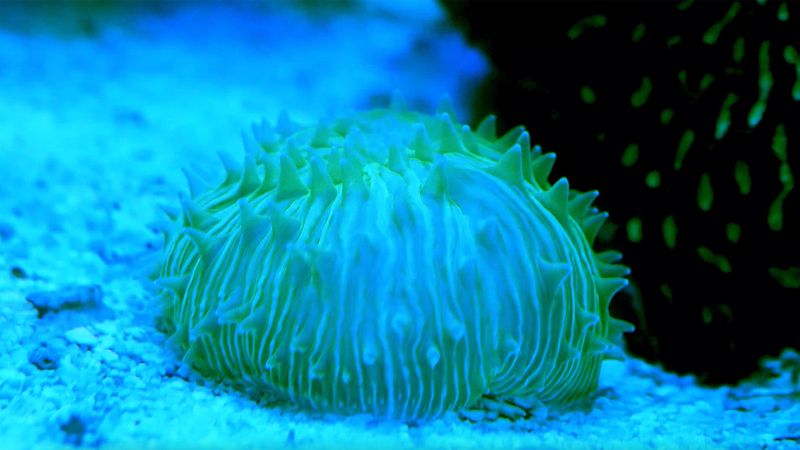Corals may not be known for their agility, but recent research reveals that the free-living mushroom coral, Cycloseris cyclolites, displays remarkable locomotion that could reshape our understanding of coral behaviors. This study uncovers how C. cyclolites actively “walks” toward blue light waves, emulating the pulsed swimming motion seen in jellyfish. The research indicates that corals possess more sophisticated movement capabilities than previously recognized, challenging longstanding perceptions of sessile organisms.
Typically, corals such as C. cyclolites are fixed in place, anchored to substrates like rocks or algae. However, this species exhibits a fascinating life cycle. Initially, they are stationary but later become mobile as their stems dissolve upon maturation. Dr. Brett Lewis, the lead author and postdoctoral research fellow at Queensland University of Technology, highlights that these corals are primarily found in the Indo-Pacific region, with potential presences in the Indian Ocean and the Red Sea.
The growth habitats of C. cyclolites are predominantly high-energy zones, which experience strong waves and heightened competition for space. Facing unfavorable conditions, younger corals, measuring up to 9 centimeters (3.5 inches), quickly migrate to deeper waters. This relocation helps them survive, reproduce, and thrive in environments with reduced wave energy, lower temperatures, and less competition for crucial resources like food and sunlight.
Although prior studies had indicated that certain free-living corals respond to light by moving, the mechanisms behind their navigation remained largely unexplored due to limitations in imaging technology. The latest findings confirm that C. cyclolites moves actively using a technique called pulsed inflation when exposed to blue light, allowing them to migrate toward light sources that are indicative of their natural habitats.
The observed movements of C. cyclolites suggest that these corals have more intricate body functions compared to jellyfish, their evolutionary relatives. Lewis and his research team collected five specimens off the coast of Cairns, Australia, transporting them to an aquarium for experimentation. By conducting trials with both blue and white light, researchers found that C. cyclolites demonstrated a strong preference for blue wavelengths, exhibiting a positive phototactic response by moving toward these light sources.
Remarkably, during blue light trials, some corals traveled distances of up to 220 millimeters (approximately 8.7 inches) over the course of 24 hours. Comparatively, only a small fraction (13.3%) exhibited movement in response to white light, with the maximum distance being a mere 8 millimeters (0.3 inches). In mixed light scenarios, the corals consistently gravitated toward the blue light while avoiding the white, further underscoring their preferences.
The findings prompted Lewis to draw an analogy with human behavior at the beach, saying, “When you go under (the water) and look back at the shore, it’s bright and clear, but when you turn around and look deeper into the ocean, it becomes dark and blue.” For C. cyclolites, this upwelling blue light provides a crucial directional cue to navigate toward deeper waters.
Marine biologist Andrew Davies, who was not part of the study, emphasized the significance of understanding how species like C. cyclolites respond to light. By examining their behaviors, researchers gain insights into the evolutionary adaptations of species that rely on light, particularly in shallow environments where it plays an essential role in their survival.
To delve deeper into the mechanics of C. cyclolites’ active movement, researchers utilized high-resolution time-lapse imaging to analyze their biomechanics. The first observations highlighted the passive movements induced by ocean waves, which often pushed corals back down the reef rather than toward their desired locations. This dynamic prompted Lewis to elaborate on how active mobility allows corals to search for appropriate habitats.
Active movement toward blue light was attributed to three primary factors: inflation of tissues, expansion of pads on the coral’s underside, and twisting dynamics of the outer tissues. These activities culminated into a process known as pulsed inflation, a survival mechanism that facilitates the corals’ movement through their environment.
Interestingly, while jellyfish utilize pulsed inflation to swim, the movement seen in C. cyclolites resembles a “walking” action across surfaces, indicating potentially similar nervous systems given their complex movements. Both Lewis and Davies suggested that understanding these behaviors could illuminate similar patterns across various coral species and help develop conservation strategies that might benefit coral restoration efforts.
As Davies succinctly put it, “If C. cyclolites is showing such strong responses to light, it could help us understand how other corals utilize light.” This study thus represents a vital leap towards decoding the ecological behaviors of corals and enhancing our approaches to conserving these critical marine ecosystems.












